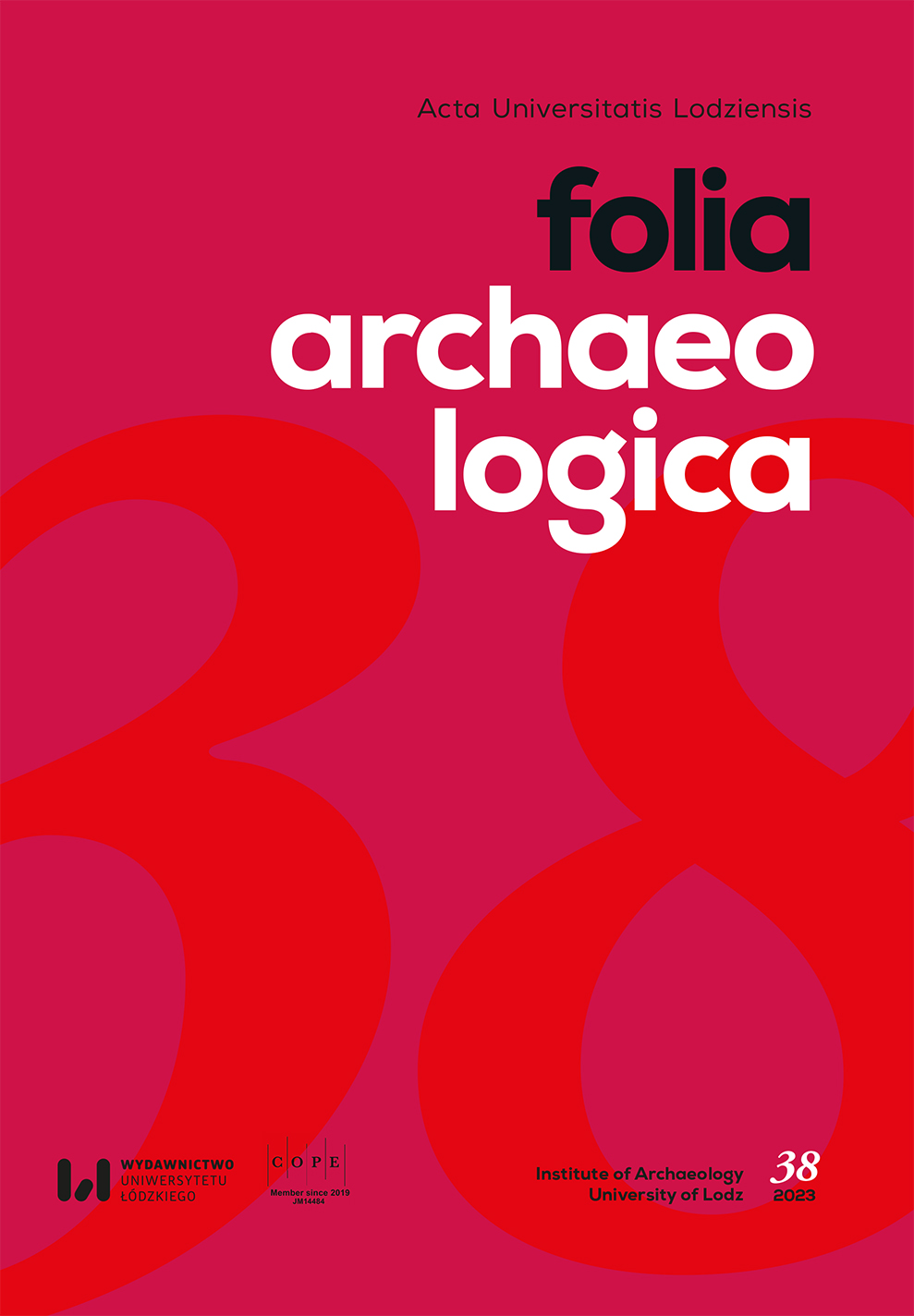Excavations of the Crypts of St. Dominic’s Church in Płock as Part of the Project “At the Intersection of Faiths and Cultures – Research on the History of St. Dominic’s Church in Płock” – Report
DOI:
https://doi.org/10.18778/0208-6034.38.02Keywords:
crypts, Płock, monastery, ossuary, Dominican Order, protestants, orthodoxAbstract
The post-Dominican St. Dominic’s Church in Płock is one of the oldest sacral buildings in the city. Together with the adjacent monastery, it bears witness to the functioning of the so-called “Górki” community, comprising three denominations: Catholics, Protestants, and the Orthodox. The Romanesque complex was erected no later than the third decade of the thirteenth century, and it held significance on the map of medieval and modern Płock. The buildings themselves have undergone little change over the centuries, making the church and monastery locations with great research potential. Regrettably, the building has not yet been subjected to comprehensive archaeological research, preceded by a source query. Rectifying this situation was the primary goal of the project “At the Intersection of Faiths and Cultures – Research on the History of St. Dominic’s Church in Płock” funded by the “Grants4NCUStudents” budget. As part of it, a research team from the Nicolaus Copernicus University in Toruń conducted preliminary archaeological research of the crypts under St. Dominic’s Church in 2022. During a series of field trips, numerous boreholes were made in the crypt space as well as in the cellars under the east wing of the monastery. The backfill of the northern entrance hole was also cleared. The preliminary work facilitated further exploration of the strata undisturbed during the cleaning work carried out in the crypt in the twentieth century. The research led to the discovery of the remains of approximately 120 people, with the bones of 16 people deposited in an ossuary made of a wooden box. Artefacts of material culture were also recovered, which allowed to date the moment and sequence of changes occurring in the crypts. The results of the conducted research enabled the precise development of a further research strategy for the post-Dominican complex in Płock.
Downloads
References
Bukowska A. (2011), Relikty architektury wczesnośredniowiecznej – formy i datowanie, [in:] A. Gołembnik (ed.), Płock wczesnośredniowieczny, Wydawnictwo Trio, Warszawa, p. 149–216.
Google Scholar
Cendrowski R. (1992), Sprawozdanie z badań archeologiczno-architektonicznych przeprowadzonych w kamienicy ul. Kościuszki 16a w Płocku, w lipcu 1992 r., Warszawa.
Google Scholar
Dudziński T., Grupa D., Grupa M., Nowak M. (2020), Badania w krypcie pod prezbiterium kościoła pw. Narodzenia Najświętszej Maryi Panny w Piasecznie, gm. Gniew, woj. Pomorskie, “Raport”, 15, p. 243–255.
Google Scholar
Grupa M. (2018), Kultura materialna w świetle badań archeologicznych w sanktuarium w Piasecznie, [in:] W. Pikor (ed.), Kultura materialna i duchowa sanktuarium w Piasecznie, Wydawnictwo “Bernardinum”, Pelplin, p. 33–43.
Google Scholar
Grupa M., Kozłowski T., Jankauskas R., Grupa D., Krajewska M., Krakowska S., Majorek M., Mosiejczyk J., Nowak M., Nowak S., Przymorska-Sztuczka M., Wojciechowska A. (2015), Secrets of the crypt in St. Ann chapel. Tajemnice krypty w kaplicy św. Anny, Stowarzyszenie Centrum Aktywnych Gniew, Gniew.
Google Scholar
Kłoczowski J. (1956), Dominikanie polscy na Śląsku w XIII–XIV w., Towarzystwo Naukowe Katolickiego Uniwersytetu Lubelskiego, Lublin, p. 291–293.
Google Scholar
Kozłowski T., Grupa M. (2019), Cognitive values of ossuaries from the cemetery and the church of St. Nicholas in Gniew, Poland, “Fasciculi Archaeologiae Historicae”, 32, p. 33–51, https://doi.org/10.23858/FAH32.2019.003
Google Scholar
DOI: https://doi.org/10.23858/FAH32.2019.003
Michalik J., Zamorowska A., Kolaska K. (2020), Badania archeologiczne w krypcie kościoła pw. Podwyższenia Krzyża Świętego w Łukowie, woj. lubelskie – sezon 2019, “Raport”, 15, p. 229–242.
Google Scholar
Pastewka M. (2018), Badania konserwatorskie i architektoniczne w budynkach A, B, C parafii prawosławnej Przemienienia Pańskiego przy ul. Kościuszki 18 w Płocku. Raport 2018, Archive of the City Historic Preservation Officer in Płock.
Google Scholar
Polak Z. (2011), Płock średniowieczny – kontynuacja czy nowa jakość?, [in:] A. Gołembnik (ed.), Płock wczesnośredniowieczny, Wydawnictwo Trio, Warszawa, p. 311–378.
Google Scholar
Skoczyński M. (2019), Contrata Masoviae. Dominikanie na Mazowszu od XIII do XVI wieku, Wydawnictwo Polskiej Prowincji Dominikanów; Wydawnictwo “W drodze”, Poznań.
Google Scholar
Stawski M. (2008), Ze Śląska na Mazowsze. Wokół początków dominikanów w Płocku. Kilka uwag krytycznych, [in:] A. Barciak (ed.), Święty Jacek Odrowąż i dominikanie na Śląsku, Wydawnictwo Polskiej Akademii Nauk, Katowice, p. 198–209.
Google Scholar
Szyma M. (2011), Architektura sakralna Płocka w XIII w. – kolegiata św. Michała i kościół św. Dominika, [in:] A. Gołembnik (ed.), Płock wczesnośredniowieczny, Wydawnictwo Trio, Warszawa, p. 279–310.
Google Scholar
Tomaszewski A. (1968), Podominikański kościół pw. Św. Dominika w Płocku. Wstępne opracowanie konserwatorskie, manuscript in the archive of the branch office of the Masovia Historic Preservation Officer in Płock, Pł/38/1046.
Google Scholar
Wołosz A.F.K. (1998), Romańska architektura kościoła pw. Św. Dominika w Płocku, “Mazowsze”, 11, p. 89–120.
Google Scholar
Zbiór dokumentów i listów miasta Płocka, 1065–1495 (1975), vol. I, Wydawnictwo S.M. Szacherska, Warszawa.
Google Scholar
Downloads
Published
How to Cite
Issue
Section
License

This work is licensed under a Creative Commons Attribution-NonCommercial-NoDerivatives 4.0 International License.












